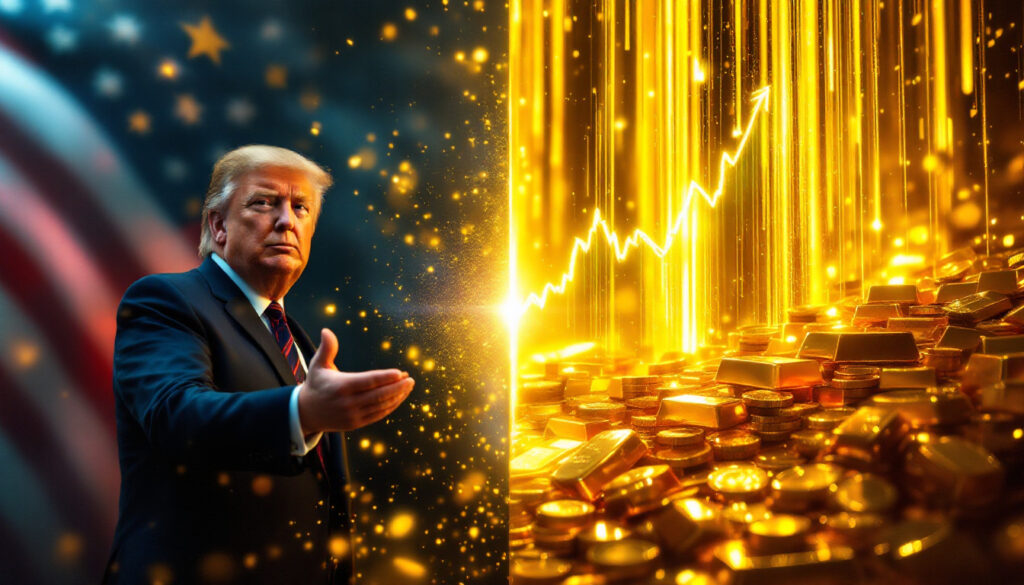How Did Gold Prices React to Trump's Tariff Decisions?
Gold's Price Movement During Market Volatility
Gold opened the trading week of April 2025 at approximately $3,020 per ounce, reflecting steady demand amid simmering trade tensions. However, by midweek, prices tumbled below $3,000 per ounce as global equity markets faced a widespread downturn. This decline, while sharp, was short-lived. By April 9th, prices rebounded sharply, culminating in a fresh all-time high of $3,185 per ounce on April 10th—a 5.46% increase from the week's opening price.
The gold price and Trump's tariff decisions created market uncertainty that underscores gold's dual role: a temporary casualty of panicked liquidations and a beneficiary of renewed safe-haven demand.
Understanding Gold's Initial Decline
Economist Gary Wagner of thegoldforecast.com contextualized the midweek dip as a product of systemic liquidity pressures rather than a fundamental shift in gold's value proposition.
"Liquidation happened across the board in multiple asset groups… to cover margin calls or increase cash positions," Wagner explained. He emphasized the decline's moderation relative to gold's prior gains, stating, "the amount of the decline is fairly calm considering how much it's gone up."
This analysis aligns with historical patterns where gold's short-term sell-offs during crises often precede rapid recoveries, particularly when triggered by policy shifts like Trump's tariff policies.
What Changes Did Trump Make to His Tariff Policy?
Trump's Surprise Tariff Reversal
On April 9th, Trump announced a 90-day pause on reciprocal tariffs for most trading partners, marking a stark reversal from prior aggressive posturing. The decision followed Trump encouraging followers on his Truth Social platform to "be cool" amid growing market anxiety.
The policy shift came after mounting pressure from White House officials, including Treasury Secretary Scott Basant, who warned of potential sell-offs in U.S. government bonds. This unexpected reversal triggered a transient rebound in major indexes like the S&P 500 and NASDAQ, though gains proved unsustainable amid lingering uncertainty about future trade policy directions.
Country-Specific Tariff Exceptions
China remained the primary target of Trump's trade policy, with tariffs soaring to 145% following retaliatory measures—a significant escalation from previously announced levels. Concurrently, 25% tariffs on Canadian and Mexican goods persisted, alongside unchanged levies on automotive and metal imports.
These targeted exceptions fragmented global trade sentiment, creating a complex trade landscape that amplified gold as a hedge against geopolitical uncertainty. Investors increasingly viewed gold as insurance against the unpredictable nature of tariff implementations and their cascading effects on global supply chains.
Why Are Experts Bullish on Gold Despite Market Uncertainty?
Gold's Undervaluation Indicators
Will Rind of Granite Shares highlighted the M2 ratio—a key metric comparing U.S. money supply to gold prices—as compelling evidence of systemic undervaluation in the gold market.
"If history's any guide, gold is closer to being undervalued than overvalued," Rind noted, pointing to the ratio's position below historical medians despite nominal price highs. This perspective is bolstered by central bank gold purchases in Q1 2025, representing a significant vote of confidence in the metal's long-term value proposition.
The M2 ratio has historically been an instructive tool for predicting major turning points in gold's price trajectory, offering a macro perspective that transcends short-term volatility caused by policy announcements like Trump's tariff decisions.
Gold as a Safe Haven Asset
Gold's -7.8% decline during the April sell-off paled against equities' steeper losses (e.g., NASDAQ's -12.3%), reinforcing its crisis resilience. This relative outperformance during market stress illustrates why investors continue to maintain bullish outlooks despite short-term price fluctuations.
Analysts attribute this resilience to gold's inverse correlation with real interest rates, which remained subdued amid Federal Reserve caution over the economic implications of trade tensions. This relationship has historically provided a buffer during periods of geopolitical uncertainty, particularly when gold price and Trump's tariff decisions create waves across multiple asset classes.
What Factors Are Creating Ongoing Market Uncertainty?
Unpredictability in Trade Policy
The 90-day tariff pause failed to quell investor anxieties, as Trump's history of abrupt policy shifts looms large over market sentiment. Negotiations during this period remain opaque, with investors pricing in a 35% probability of renewed tariffs by July 2025.
This policy uncertainty has created a paradoxical environment where even positive developments are viewed with skepticism, depressing risk assets while buoying gold's strategic allocation in institutional portfolios. Market participants remain wary that the current reprieve could be reversed with minimal notice, maintaining a heightened risk premium across asset classes.
Global Economic Implications
Treasury Secretary Basant's warnings over bond market instability echo broader concerns about U.S. fiscal sustainability in the face of trade disruptions. With China reducing its Treasury holdings by 42 billion dollars in Q1 2025, gold's role as a dollar hedge gains renewed urgency.
International trade relationships remain tense, particularly with China, as the threat of escalated tariffs continues to cast a shadow over global commerce. This environment of diplomatic uncertainty has historically benefited gold prices, as investors seek shelter from currency volatility and potential supply chain disruptions that could trigger inflationary pressures.
FAQ About Gold Prices and Tariff Impacts
How Do Tariffs Typically Affect Gold Prices?
Tariffs typically instigate currency devaluations and supply chain disruptions, driving investors toward hard assets like gold that maintain value during economic turbulence. The 2018-2020 U.S.-China trade war saw gold rise 18%, illustrating this dynamic relationship.
Gold tends to benefit from geopolitical tensions and trade disputes as investors seek assets that aren't directly tied to government policy decisions. Historical data consistently shows a positive correlation between trade tension escalation and increased gold price appreciation, particularly when policy uncertainty extends over multiple quarters.
What Metrics Should Investors Watch to Gauge Gold's Value?
Beyond the M2 ratio, investors should monitor real yields, central bank demand, and ETF inflows as critical indicators of gold's fundamental positioning. Q1 2025 ETF inflows totaled 287 metric tons, signaling institutional confidence despite price volatility.
The all-time high price points and subsequent consolidation patterns offer technical guidance, while gold's performance relative to other asset classes during market stress provides context for its defensive characteristics. Gold ETFs 2024 have proven to be a particularly reliable indicator of institutional confidence, with record acquisitions preceding several major price advances over the past decade.
What Are Experts Predicting for Gold Prices in the Current Environment?
Consensus forecasts project a $3,400–$3,500 per ounce range by Q3 2025, contingent on trade policy stability. Technical indicators suggest gold remains undervalued compared to historical metrics despite reaching new nominal highs.
Experts interviewed maintain bullish outlooks despite short-term volatility, citing ongoing policy uncertainty as likely to support continued interest in gold as both a tactical and strategic holding. The gold market analysis indicates potential for further price discovery beyond recent all-time highs remains high as institutional allocations to gold continue to increase amid concerns about traditional safe havens like government bonds.
Gold's Resilience Amid Policy Turbulence
The gold market's response to Trump's tariff decisions reveals its evolving role in modern portfolios—not merely as crisis insurance but as a strategic counterweight to policy-induced volatility. While initial price declines reflected liquidity needs rather than fundamental weakness, gold's swift recovery to new highs demonstrates investor confidence in its long-term value proposition.
In synthesizing these insights, gold's trajectory hinges on policymakers' capacity to temper volatility. Investors are advised to allocate 5–10% of portfolios to gold, leveraging its dual function as a hedge against policy uncertainty and potential growth asset amid currency debasement concerns.
The interplay between gold price and Trump's tariff decisions underscores a fundamental truth: in an era of unpredictable trade policy, gold's ancient reputation as a store of value continues to resonate with modern investors seeking stability in an increasingly uncertain economic landscape.
Want to Stay Ahead of Major Mineral Discoveries?
Discovery Alert's proprietary Discovery IQ model delivers instant notifications on significant ASX mineral discoveries, empowering investors to capitalise on opportunities before the broader market reacts to gold price movements and policy changes. Explore how historic discoveries have generated substantial returns by visiting Discovery Alert's dedicated discoveries page and begin your 30-day free trial today.




